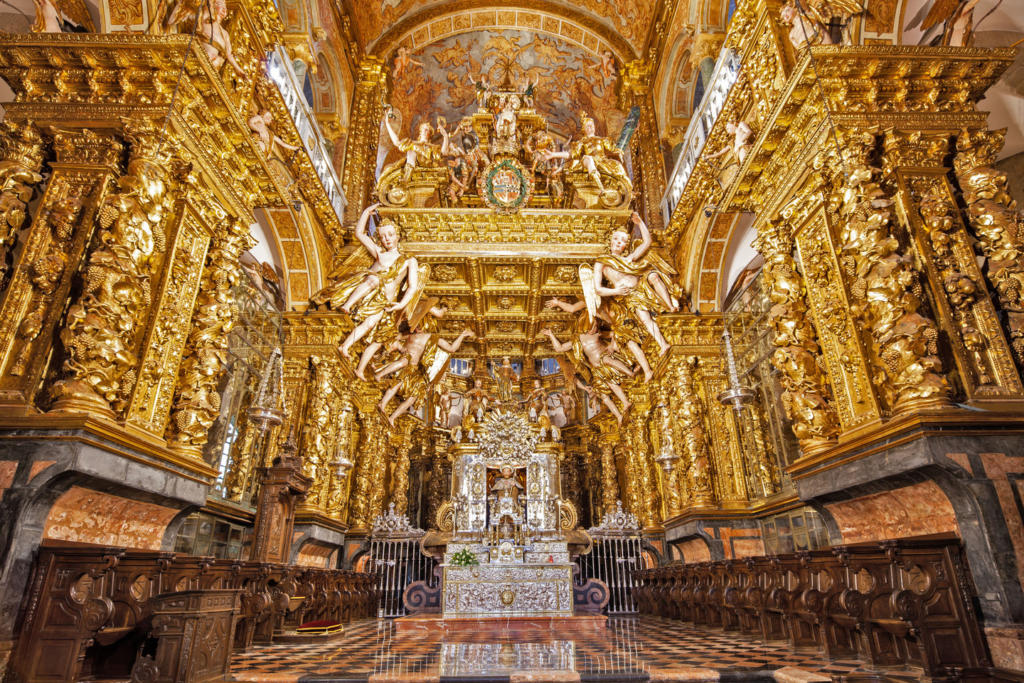Santiago de Compostela, the capital of Galicia in northwestern Spain, is a city steeped in history, culture, and religious significance. Known as the culmination point of the Camino de Santiago pilgrimage route, this UNESCO World Heritage Site offers visitors a rich tapestry of ancient architecture, vibrant traditions, and stunning landscapes. Here, we delve into the top five places to visit in this enchanting city.
1. Cathedral of Santiago de Compostela

The Cathedral of Santiago de Compostela is the crown jewel of the city and one of the most important pilgrimage sites in the Christian world. According to tradition, it houses the remains of Saint James the Apostle.
- Portico of Glory: This masterpiece of Romanesque sculpture, created by Maestro Mateo, greets visitors with its intricate carvings depicting biblical scenes.
- Botafumeiro: The giant incense thurible, weighing around 80 kg, swings across the cathedral during special services, creating a mesmerizing spectacle.
- Crypt of Saint James: The final resting place of the apostle, located beneath the main altar, where pilgrims come to pay their respects.
- Cathedral Museum: This museum offers a comprehensive look at the cathedral’s history, art, and archaeology, including the Cathedral’s cloister and the Treasury.
Travel Advice
- Early Arrival: To avoid crowds, especially during peak pilgrimage season, visit early in the morning.
- Pilgrim Mass: Attend the Pilgrim Mass at noon to witness the Botafumeiro in action.
- Roof Tour: Consider taking a guided tour of the cathedral’s roof for panoramic views of the city and insights into the architectural history.
2. Praza do Obradoiro

Praza do Obradoiro is the main square in Santiago de Compostela, surrounded by some of the city’s most significant buildings. It serves as the final destination for many pilgrims and is a bustling hub of activity.
- Hostal dos Reis Católicos: Originally a hospital for pilgrims, this stunning building is now a luxury parador (historic hotel).
- Pazo de Raxoi: This neoclassical palace houses the city hall and the regional government.
- Colegio de San Xerome: The University of Santiago de Compostela’s rectory, with a beautiful Renaissance facade.
- Rúa do Franco and Rúa da Raiña: These streets leading off the square are filled with tapas bars, restaurants, and shops, offering a taste of local cuisine and culture.
Travel Advice
- Evening Visits: The square is particularly magical in the evening when the buildings are beautifully illuminated.
- Local Cuisine: Sample traditional Galician dishes at one of the nearby eateries, such as pulpo a la gallega (Galician-style octopus) and tarta de Santiago (almond cake).
- Photo Opportunities: Capture the essence of Santiago de Compostela with photographs of the cathedral’s facade and the surrounding historic buildings.
3. Monastery of San Martín Pinario

The Monastery of San Martín Pinario is one of the largest and most important religious complexes in Spain. Located near the cathedral, it has a rich history dating back to the 10th century.
- Baroque Architecture: The monastery’s church and main building are excellent examples of Baroque architecture, with elaborate facades and richly decorated interiors.
- Museum: The museum within the monastery showcases religious art, including sculptures, paintings, and liturgical objects from various periods.
- Library: The library contains an extensive collection of historical texts and manuscripts, providing insight into the region’s scholarly and religious history.
- Cloisters: The tranquil cloisters offer a peaceful retreat and a glimpse into monastic life.
Travel Advice
- Guided Tours: Consider a guided tour to fully appreciate the history and significance of the monastery.
- Quiet Reflection: Spend some time in the cloisters for quiet reflection and to enjoy the serene atmosphere.
- Check Hours: Verify the opening hours before your visit, as they can vary seasonally.
4. Alameda Park , Santiago de Compostela

Alameda Park is Santiago de Compostela’s most famous and beloved green space. Offering beautiful views of the city and the cathedral, it is a perfect spot for a leisurely stroll or a relaxing break.
- Paseo da Ferradura: This scenic walkway offers stunning vistas of the cathedral and the old town, making it a popular route for walkers and joggers.
- Statue of the Two Marias: A colorful statue honoring two eccentric local sisters who became iconic figures in the city.
- Botanical Gardens: Explore a variety of plant species, including ancient oak trees, magnolias, and camellias.
- Bandstand: The bandstand hosts musical performances and other cultural events, adding to the park’s lively atmosphere.
Travel Advice
- Picnic Spot: Pack a picnic and enjoy it on the park’s grassy areas or benches with a view of the cathedral.
- Photography: The park offers excellent photo opportunities, especially at sunset when the light casts a golden glow over the city.
- Relaxation: Take a leisurely stroll or simply relax and people-watch, soaking in the tranquil environment.
5. Mercado de Abastos

Mercado de Abastos is the bustling central market of Santiago de Compostela, where locals shop for fresh produce, seafood, meats, and more. It provides a vibrant glimpse into daily life and culinary traditions.
- Local Produce: Discover a wide array of fresh fruits, vegetables, cheeses, and baked goods, many of which are locally sourced.
- Seafood: Galicia is renowned for its seafood, and the market offers a dazzling array of fish, shellfish, and other marine delicacies.
- Gastronomy: Enjoy a meal at one of the market’s food stalls or restaurants, which serve dishes made from the freshest ingredients available.
- Crafts and Souvenirs: Browse stalls selling handmade crafts, regional products, and unique souvenirs to take home.
Travel Advice
- Morning Visits: Visit in the morning when the market is at its busiest and the selection of goods is at its best.
- Local Specialties: Try some local specialties, such as empanadas, pimientos de Padrón, and Galician cheeses.
- Interactive Experience: Engage with vendors and ask about their products to learn more about Galician cuisine and culinary traditions.
Santiago de Compostela is a city that invites exploration and offers a rich tapestry of experiences. From the spiritual and architectural grandeur of the Cathedral of Santiago de Compostela to the vibrant daily life at Mercado de Abastos, the city seamlessly blends its historical significance with contemporary charm. By visiting these top five places, you’ll gain a deeper appreciation for the city’s cultural heritage, architectural beauty, and vibrant local life.



